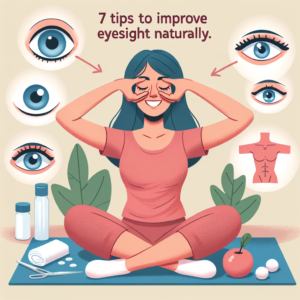PCOD / PCOS – All About Polycystic Ovarian Syndrome:
Date: April 19, 2024
PCOD / PCOS – All About Polycystic Ovarian Syndrome: PCOD (Polycystic Ovary Syndrome) is a common hormonal disorder that affects millions of women worldwide. Despite its prevalence, many people still find PCOD confusing and overwhelming. In this blog post, we’ll break down PCOD in easy language, helping you understand its causes, symptoms, and treatment options.

What is PCOD?
Polycystic Ovary Syndrome (PCOD) is a hormonal disorder that affects the ovaries, the reproductive organs in women. Normally, the ovaries produce eggs every month as part of the menstrual cycle. However, in PCOD, the ovaries may not release eggs regularly, leading to irregular menstrual periods and other symptoms.
Causes of PCOD: The exact cause of PCOD is not fully understood, but several factors may contribute to its development. These include:
- Hormonal Imbalance: PCOD is often associated with an imbalance in hormones, particularly insulin and androgens (male hormones like testosterone).
- Genetics: There may be a genetic predisposition to PCOD, meaning it can run in families.
- Lifestyle Factors: Poor diet, lack of exercise, and stress can exacerbate hormonal imbalances and contribute to PCOD.
- Insulin Resistance: Insulin resistance, where the body’s cells do not respond properly to insulin, may play a role in PCOD development.
Symptoms of PCOD:
PCOD can manifest in various ways, and symptoms may vary from person to person. Common symptoms include:
- Irregular Menstrual Periods:
- One of the hallmark symptoms of PCOS is irregular menstrual cycles. Women with PCOS may have unpredictable periods, with intervals longer than 35 days or fewer than eight menstrual cycles per year.
- Excessive Hair Growth (Hirsutism):
- PCOS can cause hirsutism, which is the abnormal growth of coarse, dark hair in areas typically associated with male patterns of hair growth. This often includes the face (such as the upper lip, chin, and cheeks), chest, back, and abdomen.
- Acne and Oily Skin:
- Hormonal imbalances in PCOS can lead to an overproduction of oil in the skin, resulting in acne breakouts and oily skin. Acne in PCOS tends to be persistent and may not respond well to typical acne treatments.
- Weight Gain and Difficulty Losing Weight:
- Many women with PCOS struggle with weight management. Hormonal imbalances, particularly insulin resistance, can lead to weight gain, especially around the abdomen. Losing weight can be challenging for women with PCOS, even with diet and exercise.
- Hair Loss (Alopecia):
- PCOS can also cause hair thinning or hair loss, particularly in a male-pattern baldness pattern. This can be distressing for women and may affect self-esteem and confidence.
- Darkening of Skin (Acanthosis Nigricans):
- Some women with PCOS may develop acanthosis nigricans, a condition characterized by dark, velvety patches of skin, typically in body folds such as the neck, armpits, groin, or under the breasts. This darkening of the skin is often associated with insulin resistance.
- Pelvic Pain:
- Some women with PCOS may experience pelvic pain or discomfort, particularly during menstruation or ovulation. This pain can vary in intensity and may be accompanied by other symptoms such as bloating or cramping.
- Fertility Issues:
- PCOS is a leading cause of infertility in women. Irregular ovulation or the lack of ovulation altogether can make it challenging to conceive naturally. Women with PCOS may require medical assistance, such as fertility medications or assisted reproductive technologies, to achieve pregnancy.
Diagnosis and Treatment:
Diagnosing PCOD involves a combination of medical history, physical examination, and laboratory tests, including hormone levels and ultrasound imaging of the ovaries.

Treatment for PCOD focuses on managing symptoms and addressing underlying hormonal imbalances. Treatment options may include:
-
- Lifestyle Changes:
- Healthy Diet: Adopting a balanced diet rich in fruits, vegetables, lean proteins, and whole grains can help regulate blood sugar levels and improve insulin sensitivity. Limiting processed foods, sugary snacks, and refined carbohydrates is also recommended.
- Regular Exercise: Engaging in regular physical activity, such as brisk walking, jogging, cycling, or strength training, can aid in weight management, reduce insulin resistance, and improve overall health.
- Stress Management: Chronic stress can exacerbate hormonal imbalances in PCOS. Incorporating stress-reducing activities such as yoga, meditation, deep breathing exercises, or hobbies can help manage stress levels.
- Medications:
- Birth Control Pills: Oral contraceptives containing estrogen and progestin can help regulate menstrual cycles, reduce androgen levels, and alleviate symptoms such as acne and hirsutism.
- Anti-Androgen Medications: Medications such as spironolactone or flutamide may be prescribed to reduce the effects of androgens on the body, helping to improve acne, hirsutism, and hair loss.
- Metformin: This medication is commonly used to treat insulin resistance and type 2 diabetes. In PCOS, metformin can improve insulin sensitivity, regulate menstrual cycles, and aid in weight loss.
- Ovulation Induction: For women trying to conceive, fertility medications such as clomiphene citrate or letrozole may be prescribed to induce ovulation and improve the chances of pregnancy.
- Gonadotropins: In some cases, injectable medications known as gonadotropins may be used to stimulate ovulation in women with PCOS who do not respond to oral medications.
- Management of Symptoms:
- Topical Treatments: Over-the-counter or prescription topical treatments, such as retinoids or benzoyl peroxide, may be used to manage acne associated with PCOS.
- Hair Removal Methods: Various hair removal methods, including shaving, waxing, threading, or laser hair removal, can help manage hirsutism.
- Scalp Treatments: For women experiencing hair loss or thinning, treatments such as minoxidil (Rogaine) or low-level laser therapy may be recommended to promote hair growth.
- Fertility Treatments:
- In Vitro Fertilization (IVF): In cases of infertility related to PCOS, assisted reproductive technologies such as IVF may be recommended. IVF involves retrieving eggs from the ovaries, fertilizing them with sperm in a laboratory, and transferring the resulting embryos into the uterus.
- Nutritional Supplements:
- Some women with PCOS may benefit from supplements such as inositol, omega-3 fatty acids, vitamin D, and chromium picolinate, which have been shown to help improve insulin sensitivity and hormone balance.
- Lifestyle Changes:
- It’s important to note that the treatment plan for PCOS should be individualized based on the woman’s specific symptoms, health status, and reproductive goals. A healthcare provider, typically a gynecologist or endocrinologist, can work with the patient to develop a comprehensive treatment plan tailored to her needs. Additionally, regular monitoring and follow-up appointments are essential to assess the effectiveness of treatment and make any necessary adjustments.
Life style changes:

- Healthy Diet:
- Balanced Macronutrients: Aim for a balanced diet that includes a combination of carbohydrates, proteins, and healthy fats. Focus on whole foods such as fruits, vegetables, whole grains, lean proteins (like chicken, fish, tofu, and legumes), and healthy fats (such as avocados, nuts, seeds, and olive oil).
- Low Glycemic Index Foods: Choose foods with a low glycemic index (GI), which cause a slower and more gradual increase in blood sugar levels. Examples of low-GI foods include non-starchy vegetables, whole grains, legumes, and most fruits.
- Limit Sugary Foods and Refined Carbohydrates: Minimize the consumption of sugary snacks, sugary beverages, processed foods, and refined carbohydrates (such as white bread, white rice, and sugary cereals), as these can spike blood sugar levels and worsen insulin resistance.
- Portion Control: Be mindful of portion sizes to avoid overeating and excessive calorie intake. Use smaller plates, bowls, and utensils to help control portion sizes.
- Hydration: Drink plenty of water throughout the day to stay hydrated and support overall health. Limit intake of sugary beverages and opt for water, herbal tea, or infused water instead.
- Regular Exercise:
- Aerobic Exercise: Engage in regular aerobic exercise, such as brisk walking, jogging, cycling, swimming, or dancing, for at least 150 minutes per week (or about 30 minutes on most days of the week). Aerobic exercise helps improve insulin sensitivity, promote weight loss, and reduce cardiovascular risk factors.
- Strength Training: Incorporate strength training exercises, such as weightlifting or bodyweight exercises, into your routine at least two days per week. Strength training helps build muscle mass, increase metabolism, and improve body composition.
- Variety: Keep your exercise routine varied and enjoyable by trying different activities and workouts. Consider activities like yoga, Pilates, hiking, or group fitness classes to add variety and keep motivation high.
- Stress Management:
- Mindfulness and Relaxation Techniques: Practice stress-reducing techniques such as mindfulness meditation, deep breathing exercises, progressive muscle relaxation, or guided imagery to help manage stress levels and promote relaxation.
- Hobbies and Leisure Activities: Engage in activities that bring you joy and relaxation, such as reading, gardening, cooking, crafting, or spending time outdoors. Taking time for hobbies and leisure activities can help reduce stress and improve overall well-being.
- Time Management: Prioritize tasks, set realistic goals, and establish boundaries to manage time effectively and reduce feelings of overwhelm and stress.
- Sleep Hygiene:
- Consistent Sleep Schedule: Aim for a consistent sleep schedule by going to bed and waking up at the same time each day, even on weekends. Establishing a regular sleep routine helps regulate the body’s internal clock and improve sleep quality.
- Create a Relaxing Sleep Environment: Create a sleep-friendly environment by keeping your bedroom dark, quiet, and cool. Minimize exposure to electronic devices and screens before bedtime, as blue light can interfere with sleep quality.
- Limit Stimulants: Avoid consuming caffeine and other stimulants in the evening, as they can disrupt sleep patterns and make it difficult to fall asleep.
Challenges with PCOD:
Women with PCOS (Polycystic Ovary Syndrome) may face specific challenges and considerations when it comes to pregnancy. While many women with PCOS can conceive and have healthy pregnancies, it’s essential to take certain precautions and make lifestyle adjustments to optimize fertility and ensure a healthy pregnancy. Here are some precautions for women with PCOS who are planning for pregnancy:

- Consult with a Healthcare Provider:
- Before trying to conceive, it’s important to consult with a healthcare provider, preferably an obstetrician/gynecologist (OB/GYN) or a reproductive endocrinologist who specializes in fertility and PCOS. They can provide personalized advice, perform a comprehensive evaluation, and address any concerns or questions you may have.
- Optimize Your Health:
- Prioritize your overall health and well-being by adopting a healthy lifestyle. This includes maintaining a balanced diet, engaging in regular physical activity, managing stress, getting enough sleep, and avoiding harmful substances such as tobacco, alcohol, and recreational drugs.
- Manage Weight:
- Achieving and maintaining a healthy weight can improve fertility outcomes and reduce the risk of complications during pregnancy. If you’re overweight or obese, losing even a modest amount of weight (5-10% of body weight) can help regulate menstrual cycles, improve ovulation, and increase the likelihood of conception.
- Monitor Menstrual Cycles:
- Keep track of your menstrual cycles and ovulation using methods such as menstrual calendars, ovulation predictor kits, or fertility tracking apps. This can help identify your fertile window and optimize timing for intercourse to maximize the chances of conception.
- Address Hormonal Imbalances:
- Work with your healthcare provider to address any hormonal imbalances associated with PCOS, such as elevated androgen levels or insulin resistance. Medications such as metformin, clomiphene citrate, or letrozole may be prescribed to regulate menstrual cycles and induce ovulation.
- Consider Fertility Treatments:
- Depending on your individual circumstances and fertility goals, fertility treatments such as ovulation induction, intrauterine insemination (IUI), or in vitro fertilization (IVF) may be recommended. These treatments can help overcome ovulatory dysfunction and increase the likelihood of pregnancy.
- Monitor and Manage Gestational Diabetes Risk:
- Women with PCOS have an increased risk of developing gestational diabetes during pregnancy. Attend prenatal appointments regularly, undergo recommended glucose screening tests, and follow dietary and lifestyle recommendations to manage blood sugar levels and reduce the risk of complications.
- Stay Informed and Advocated:
- Educate yourself about PCOS, fertility, and pregnancy-related topics. Be proactive in advocating for your health and seeking appropriate medical care. Don’t hesitate to ask questions, express concerns, and communicate openly with your healthcare provider throughout the preconception and pregnancy journey.
By incorporating these lifestyle changes into your daily routine, you can help manage symptoms, improve hormonal balance, and enhance overall health and well-being in PCOS. It’s essential to approach lifestyle changes as long-term habits rather than short-term fixes, as consistency and persistence are key to achieving lasting results.
PCOD (Polycystic Ovarian Disease) and PCOS (Polycystic Ovary Syndrome) are terms often used interchangeably, but they actually refer to slightly different aspects of the same condition. Here’s the difference between PCOD and PCOS:
-
Polycystic Ovarian Disease (PCOD):
- PCOD primarily refers to the presence of multiple cysts on the ovaries, which can be detected via ultrasound imaging. These cysts are small, fluid-filled sacs that form on the ovaries.
- PCOD is more of a descriptive term based on the physical appearance of the ovaries and may not always be associated with specific symptoms or hormonal imbalances.
- In some cases, women with PCOD may not exhibit symptoms of hormonal imbalance, such as irregular menstrual cycles, acne, hirsutism (excessive hair growth), or weight gain.
-
Polycystic Ovary Syndrome (PCOS):
- PCOS is a broader and more comprehensive term that encompasses not only the presence of ovarian cysts but also the associated hormonal imbalances and symptoms.
- In addition to ovarian cysts, PCOS is characterized by hormonal imbalances, including elevated levels of androgens (male hormones such as testosterone) and insulin resistance.
- PCOS is often associated with a range of symptoms, including irregular menstrual periods, acne, hirsutism, hair loss, weight gain or difficulty losing weight, and fertility issues.
- The diagnosis of PCOS typically involves a combination of clinical symptoms, physical examination, laboratory tests (such as hormone levels), and imaging studies (such as ultrasound) to assess ovarian morphology.
Conclusion: PCOD can have a significant impact on a woman’s health and quality of life, but with the right understanding and management, it is possible to effectively manage its symptoms and improve overall well-being. By demystifying PCOD in simple terms, we hope to empower women to take control of their health and seek appropriate care when needed. If you suspect you may have PCOD or are experiencing symptoms, consult with a healthcare provider for proper evaluation and management.
Remember, you’re not alone in this journey, and there are resources and support available to help you navigate PCOD with confidence.
PCOD
Frequently Asked Questions (FAQs) about PCOD (Polycystic Ovary Syndrome) along with their answers:
- What is PCOD?
- PCOD stands for Polycystic Ovary Syndrome, a hormonal disorder that affects women of reproductive age.
- What causes PCOD?
- The exact cause of PCOD is unknown, but it is believed to involve a combination of genetic, hormonal, and lifestyle factors.
- What are the symptoms of PCOD?
- Common symptoms of PCOD include irregular menstrual periods, acne, hirsutism (excess hair growth), weight gain, and fertility issues.
- Is PCOD the same as PCOS?
- Yes, PCOD and PCOS are often used interchangeably, although PCOS is considered a more comprehensive term that encompasses ovarian cysts along with hormonal imbalances and associated symptoms.
- How is PCOD diagnosed?
- PCOD is diagnosed based on clinical symptoms, physical examination, laboratory tests (such as hormone levels), and imaging studies (such as ultrasound to visualize ovarian morphology).
- Is PCOD curable?
- PCOD is a chronic condition that cannot be cured, but its symptoms can be managed through lifestyle changes, medications, and other treatments.
- Can PCOD be reversed?
- While PCOD cannot be reversed, its symptoms can be alleviated and managed effectively with appropriate treatment and lifestyle modifications.
- Can PCOD cause infertility?
- PCOD is a leading cause of infertility in women due to irregular ovulation or lack of ovulation. However, many women with PCOD can conceive with appropriate medical intervention.
- What is the treatment for PCOD?
- Treatment for PCOD focuses on managing symptoms and addressing underlying hormonal imbalances. This may include lifestyle changes, medications, fertility treatments, and management of specific symptoms
- Can diet help with PCOD?
- Yes, a healthy diet rich in fruits, vegetables, lean proteins, and whole grains can help regulate blood sugar levels, improve insulin sensitivity, and manage symptoms of PCOD.
- Is weight gain common in PCOD?
- Yes, many women with PCOD experience weight gain or have difficulty losing weight due to hormonal imbalances and insulin resistance.
- What are the risks of PCOD during pregnancy?
- Women with PCOD may have an increased risk of gestational diabetes, preeclampsia, and preterm birth during pregnancy.
- Can PCOD affect menstrual cycles?
- Yes, PCOD can cause irregular menstrual cycles, including infrequent or absent periods, due to hormonal imbalances and irregular ovulation.
- Can PCOD cause hair loss?
- Yes, hair loss or thinning (alopecia) may occur in some women with PCOD due to hormonal imbalances and increased androgen levels.
- What is insulin resistance in PCOD?
- Insulin resistance occurs when the body’s cells do not respond properly to insulin, leading to elevated blood sugar levels. Insulin resistance is common in PCOD and may contribute to weight gain and other symptoms.
- Can PCOD be detected through ultrasound?
- Yes, PCOD can be detected through ultrasound imaging, which may reveal the presence of multiple small cysts on the ovaries.
- Does PCOD increase the risk of other health conditions?
- Yes, women with PCOD have an increased risk of developing type 2 diabetes, cardiovascular disease, and other metabolic disorders.
- Can PCOD be passed down genetically?
- There appears to be a genetic component to PCOD, as it tends to run in families. However, the exact genetic factors involved are not fully understood.
- Is there a link between PCOD and mental health?
- Some studies suggest a possible association between PCOD and mental health conditions such as depression, anxiety, and eating disorders. However, more research is needed to understand the nature of this relationship.
- Can PCOD affect libido?
- Yes, PCOD may affect libido or sexual desire in some women due to hormonal imbalances and other related factors.
- Does PCOD increase the risk of ovarian cancer?
- While women with PCOD may have a slightly higher risk of ovarian cancer compared to the general population, the overall risk remains low. Regular monitoring and early detection can help manage this risk.
- Can PCOD affect skin health?
- Yes, PCOD can affect skin health and may lead to acne, oily skin, and darkening of the skin in certain areas, particularly skin folds.
- What role does stress play in PCOD?
- Chronic stress can exacerbate hormonal imbalances and insulin resistance in PCOD, potentially worsening symptoms such as irregular periods and weight gain.
- Is there a link between PCOD and sleep disorders?
- Some research suggests a possible association between PCOD and sleep disorders such as obstructive sleep apnea. However, more studies are needed to fully understand this relationship.
- Can PCOD affect thyroid function?
- PCOD may be associated with thyroid disorders such as hypothyroidism (underactive thyroid) or Hashimoto’s thyroiditis. Regular thyroid screening may be recommended for women with PCOD.
- Can PCOD be managed without medication?
- While medications are often used to manage symptoms of PCOD, lifestyle changes such as diet, exercise, and stress management can also play a significant role in symptom management.
- Does PCOD affect bone health?
- PCOD may be associated with an increased risk of osteoporosis or bone thinning due to hormonal imbalances and decreased estrogen levels. Adequate calcium intake and weight-bearing exercise can help support bone health.
- Can PCOD cause mood swings?
- Yes, hormonal fluctuations in PCOD may contribute to mood swings, irritability, or mood disorders such as depression and anxiety.
- Can PCOD affect fertility in men?
- While PCOD is a condition that primarily affects women, some research suggests that male partners of women with PCOD may have a slightly higher risk of infertility or subfertility. However, more research is needed to confirm this association.
- Does PCOD increase the risk of miscarriage?
- Women with PCOD may have a slightly higher risk of miscarriage compared to women without the condition. However, many women with PCOD go on to have successful pregnancies with appropriate medical care.
- Can PCOD affect hormone levels?
- Yes, PCOD is characterized by hormonal imbalances, including elevated levels of androgens (male hormones) such as testosterone and insulin resistance.
- Can PCOD affect cholesterol levels?
- PCOD may be associated with dyslipidemia or abnormal cholesterol levels, including elevated levels of LDL cholesterol (bad cholesterol) and triglycerides.
- Can PCOD cause pelvic pain?
- Some women with PCOD may experience pelvic pain or discomfort, particularly during menstruation or ovulation. This pain can vary in intensity and may be accompanied by other symptoms such as bloating or cramping.
- Is PCOD more common in certain ethnicities?
- PCOD can affect women of all ethnicities and races, but some studies suggest that certain ethnic groups may have a higher prevalence of the condition.
- Can PCOD affect insulin levels?
- Yes, PCOD is often associated with insulin resistance, where the body’s cells do not respond properly to insulin, leading to elevated insulin levels and increased risk of type 2 diabetes.
- Can PCOD affect liver function?
- Some research suggests that women with PCOD may be at increased risk of non-alcoholic fatty liver disease (NAFLD) due to insulin resistance and metabolic abnormalities. Regular liver function tests may be recommended for women with PCOD.
- Can PCOD affect kidney function?
- PCOD may be associated with an increased risk of kidney disorders such as chronic kidney disease (CKD) due to metabolic abnormalities and insulin resistance.
- Is PCOD associated with autoimmune diseases?
- Some studies suggest a possible association between PCOD and autoimmune diseases such as autoimmune thyroiditis (Hashimoto’s thyroiditis) or systemic lupus erythematosus (SLE). However, more research is needed to confirm this relationship.
- Can PCOD affect fertility treatments?
- Women with PCOD may require fertility treatments such as ovulation induction, intrauterine insemination (IUI), or in vitro fertilization (IVF) to overcome ovulatory dysfunction and increase the likelihood of pregnancy.
- Can PCOD affect breast health?
- Some research suggests that women with PCOD may have an increased risk of breast cancer, although the evidence is not conclusive. Regular breast cancer screening is recommended for all women, including those with PCOD.
- Is PCOD associated with heart disease?
- Women with PCOD have an increased risk of developing cardiovascular disease (CVD) due to metabolic abnormalities, insulin resistance, and dyslipidemia. Lifestyle changes and regular cardiovascular screening may help reduce this risk.
- Can PCOD affect gut health?
- Some research suggests a possible association between PCOD and gastrointestinal disorders such as irritable bowel syndrome (IBS) or inflammatory bowel disease (IBD). However, more studies are needed to fully understand this relationship.
- Can PCOD affect lung function?
- PCOD may be associated with an increased risk of respiratory disorders such as asthma or obstructive sleep apnea (OSA) due to hormonal imbalances and obesity-related factors.
- Can PCOD affect eye health?
- Some research suggests that women with PCOD may have an increased risk of eye disorders such as glaucoma or diabetic retinopathy due to metabolic abnormalities and insulin resistance.
- Can PCOD affect hair quality?
- Yes, PCOD can affect hair quality and may lead to hair thinning, brittle hair, or changes in hair texture due to hormonal imbalances and other related factors.






